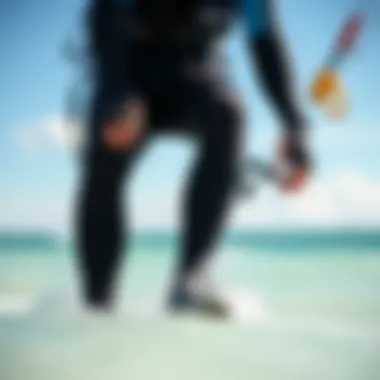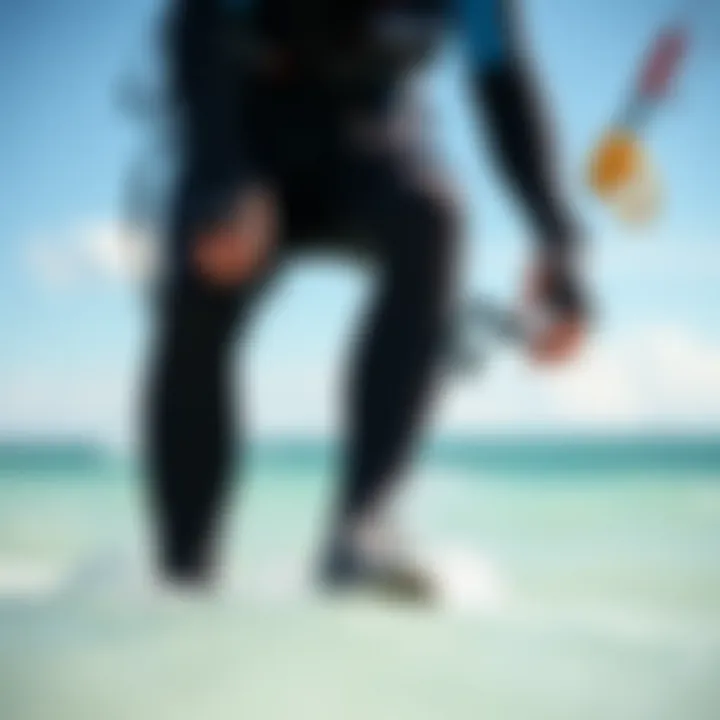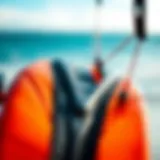A Complete Guide to Patagonia Springsuits for Kiteboarding


Intro
Kiteboarding is not merely an adrenaline-pumping sport; it's a symphony of power, finesse, and engagement with the elements. One of the cornerstones of enjoying this thrilling activity lies in selecting the right gear, specifically your wetsuit. Among the myriad choices available, the Patagonia springsuit stands tall, encapsulating a blend of innovation, comfort, and sustainability.
This guide will dive into the details that differentiate the Patagonia springsuit from other options. For kiteboarders, the right fit and materials can mean the difference between an exhilarating experience riding the waves or a chilly ordeal that dampens the spirits. This article will dissect the specific elements of the springsuit including its construction, unique features, various styles, and the practicalities of maintenance. Not to mention the increasing relevance of sustainability in today’s gear selections, a decisive factor for many environmentally-conscious riders.
By addressing topics like design, materials, functionality, and user feedback, we intend to offer kiteboarding enthusiasts a thorough understanding of why the Patagonia springsuit might just be what you need to elevate your experience on the water. Whether you're a seasoned kiteboarder or a novice looking to dip your toes in, it’s imperative to be equipped with the right information to make informed gear choices that align with your water adventures.
Let’s embark on this journey and explore how the Patagonia springsuit can seamlessly integrate into your kiteboarding escapades, ensuring you ride the winds with confidence and comfort.
Prelude to the Patagonia Springsuit
Kiteboarding stands as one of the most exhilarating ways to engage with the water, drawing enthusiasts from all corners of the globe. Yet, the thrill of cutting through waves and catching the wind's power comes with its own set of challenges, chiefly, the need for adequate gear. That's where the Patagonia springsuit makes a noteworthy appearance. This section endeavors to explain the significance of the Patagonia springsuit, shedding light on its pivotal role in elevating the kiteboarding experience.
The first thing to consider is functionality. Springsuits are designed with specific utilities in mind, blending comfort and protection in a way that can significantly affect performance. Unlike traditional wetsuits, which may be too hefty or cumbersome during warmer seasons, the springsuit provides sufficient coverage without restricting movement. This quality becomes especially essential when eking out the most from one's kiteboarding pursuits.
Another key aspect is material. Patagonia is known for its commitment to using advanced fabrics that not only offer flexibility but also durability. The right springsuit can mean the difference between a great day out on the water and one where you are constantly aware of discomfort or restriction. The breathability and quick-drying nature of these materials help keep moisture at bay while ensuring that you remain comfortable in varying weather conditions.
Furthermore, it’s worth noting that the springsuit accommodates a wide range of body types. Whether you're looking for something closer to your skin or more room in the seat, the Patagonia springsuit offers various cuts and fits, thus allowing kiteboarders to express their individuality while ensuring all-around functionality.
When considering the Patagonia springsuit, users should also factor in seasonal variability. The suit's versatility means that it can serve the kiteboarder well across different water conditions and temperate climates. It stands to reason that a well-informed choice can amplify one's enjoyment out on the water.
In retrospect, the introduction of the Patagonia springsuit sets the stage for a deeper understanding of its design features, varieties, and the essential impact it has on kiteboarding experiences. The subsequent sections will dig deeper into these facets, leaving no stone unturned to equip kiteboarding enthusiasts with all they need to know.
Understanding Springsuits
Grasping the concept of springsuits is crucial for kiteboarders looking to enhance their experience on the water. A springsuit stands apart from other wetsuits primarily because of its unique design intended to offer a balance between thermal protection and mobility. This section delves into what springsuits are, why they matter, and how they fit into the kit of a kiteboarder.
Definition and Purpose
At its core, a springsuit is a type of wetsuit designed for warmer water conditions. Unlike full wetsuits that provide extensive coverage, springsuits typically come with shorter sleeves and legs, aiming for optimal freedom of movement. The purpose of a springsuit goes beyond mere protection from the chill of the water; it also ensures that kiteboarders can maneuver easily, allowing for the agility needed to perform tricks and navigate swiftly.
Springsuits are often made from neoprene, a stretchy material providing insulation while allowing the skin to breathe. This is especially beneficial for kiteboarders who spend long hours out in the sun and need something that can offer comfort without overheating.
Often favored in late spring and early fall, springsuits allow enthusiasts to make the most of transitional months when temperatures are mild but still warrant some protection against the elements. For kiteboarders, a well-fitting springsuit means less fatigue and improved performance throughout their sessions.
The Functionality of Springsuits in Kiteboarding
The functionality provided by springsuits significantly impacts a kiteboarder's overall performance. Here, we discuss several vital aspects:
- Mobility: Springsuits are tailored with articulated cuts, promoting seamless movement. This ensures that as riders jump and twist, they won’t feel restricted by their gear.
- Thermal Protection: While not as warm as full wetsuits, springsuits still provide a necessary barrier against chilly waters. This is particularly salient for kiteboarders who might frequently encounter gusty winds and dropping temperatures.
- Sun Protection: Many springsuits now incorporate UV-blocking materials, which can be a game-changer in sunny climates. Kiteboarders are often exposed to prolonged sunlight, and this added protection helps to reduce the risk of sunburn.
- Quick Drying: A well-designed springsuit dries relatively quickly once out of the water, making it more comfortable during breaks and between sessions.
In summary, understanding springsuits is key for kiteboarders looking to select equipment that complements their style and enhances their performance. With the right springsuit, a kiteboarder can focus on what matters most: enjoying the thrill of the ride!
Design Features of the Patagonia Springsuit
When it comes to selecting a springsuit for kiteboarding, the design features of the Patagonia springsuit play a crucial role. This piece of gear needs to offer more than just protection from the elements. It must ensure mobility, comfort, and durability while also being eco-conscious. Let’s break down the key aspects that contribute to the overall effectiveness of these springsuits.
Material Composition
The material composition of the Patagonia springsuit is arguably one of its standout features. Patagonia is well-known for utilizing high-quality, sustainable materials in their products. Typically, these springsuits are made from recycled neoprene, providing flexibility and warmth while minimizing environmental impact. The use of limestone-based neoprene is becoming a trend, as it has a lower carbon footprint compared to traditional petroleum-based options.
Moreover, these materials are designed to withstand the rigors of kiteboarding, offering excellent resistance to wear and tear. Not every material can stand up to the saltwater and sand that comes with kiteboarding, and Patagonia has found a balance that delivers both performance and environmental responsibility. The result? A springsuit that not only hugs the body snugly but also withstands the test of time and waves.
Cut and Fit


The cut and fit of the Patagonia springsuit are essential components that influence the rider's experience on the water. An effective springsuit should fit like a second skin without being too constrictive. Patagonia tackles this by designing their suits with strategic seams and panel placements that enhance flexibility. This kind of design ensures that kiteboarders can make swift, agile movements without feeling held back.
Also, you have the option to choose between a range of sizes that accommodate various body types. Patagonia often emphasizes ergonomics in their design, meaning that the springsuit is tailored to move with you rather than against you. Whether you are making sharp turns or sensational jumps, the springsuit's fit is something to take into account seriously.
Thermal Insulation Properties
When kiteboarding in cooler waters, having adequate thermal insulation can mean the difference between an enjoyable experience and a lesson in hypothermia. The Patagonia springsuit excels in this area, featuring thermal insulation layers designed to trap body heat while still allowing moisture to escape. This balance is vital; too warm and you risk overheating, but too cold can lead to serious discomfort.
The integrated thermal lining in the suit provides warmth in brisk conditions, particularly during transitional weather when water temperatures may fluctuate. Kiteboarders navigating chilly waters can rely on Patagonia’s thoughtful insulation layer, giving them the confidence to dominate the waves.
With the right thermal insulation, kiteboarders can stay focused on their performance instead of battling the cold.
Varieties of Patagonia Springsuits
Understanding the varieties of Patagonia springsuits is crucial for kiteboarders, as it allows them to align their selection with specific water conditions, personal style, and comfort. When you step onto the water, the right springsuit can make or break your experience. Choosing the proper style and fit not only enhances performance but also boosts confidence when tackling the waves and catching the breeze.
Short-Sleeve vs. Long-Sleeve
The debate between short-sleeve and long-sleeve springsuits revolves around temperature regulation and personal preference.
Short-sleeve springsuits are perfect for warmer environments. They grant greater mobility in the arms, which is essential for kiteboarding maneuvers. Adding style points, many kiteboarders love the look too—it feels like an extension of your own skin.
However, when temperatures drop or if you’re dealing with chilly breezes, long-sleeve variants come into play. They provide essential warmth and protection from sun exposure, which can be significant even on overcast days. Not to forget, they shield against potential scrapes and cuts from unexpected encounters with the gear or aquatic life.
"Choosing the right sleeve length can change your kiteboarding experience just like that. Stay warm, stay stylish."
Thickness Options and Their Applications
The thickness of a springsuit can make a world of difference depending on your surroundings. Patagonia offers a range of thicknesses, usually marked by millimeters, to effectively manage thermal insulation.
- 2mm springsuits are ideal for warm waters, allowing for ample flexibility while still providing just enough coverage during those invigorating sessions.
- 3mm options strike a balance, suited for transitional seasons or slightly colder waters. They deliver extra warmth without feeling too cumbersome.
- 4mm and above cater to those venturing into serious cold water territory. These thicker suits ensure that you stay warm even in frigid temperatures, where prolonged exposure could pose a risk.
Choosing the right thickness is essential. It’s about finding that sweet spot where you remain comfortable but not overly hot. Always consider the water and air temperatures and remember that it’s better to be one thickness up than shivering your way through your time.
Gender-Specific Designs
Finally, let’s talk about how Patagonia recognises the diverse needs of kiteboarder demographics. Gender-specific designs are tailored to enhance fit and comfort.
For men, the focus might lean toward more streamlined cuts that prioritize flexibility without compromising warmth. For women, the designs often consider body conformation differently to ensure optimal fit and function, offering more contouring and adjustments to prevent bunching or restrictions during those high-energy rides.
Moreover, styling features, colors, and patterns can also differ. On a practical level, gender-specific designs offer enhanced performance and comfort, a critical aspect when you're harnessing winds to propel you through the waves.
Embracing the variety in springsuit options is more than just about aesthetics; it's about choosing the right gear that complements your unique shape and enhances your kiteboarding journey. With several options available, from sleeves to thickness and fit, there's a Patagonia springsuit to suit every kiteboarder's needs.
The Role of Springsuits in Various Water Conditions
Understanding how springsuits operate in different water conditions is crucial for kiteboarders. Whether you are carving through the waves in warm seas or pushing your limits in colder waters, the right springsuit enhances your performance and comfort. Over the years, the demand for a reliable wetsuit has risen, and it showcases how essential it is to align with environmental elements.
Warm Water Applications
In balmy climates and during warmer months, a springsuit serves as an excellent option for kiteboarders. Generally made from lighter material, these suits provide sufficient warmth without overheating the wearer. When temperatures rise above twenty degrees Celsius, the last thing a rider wants is to feel weighed down.
- Breathability and Comfort: A well-designed springsuit allows for air circulation, which keeps the body cool and makes movement effortless. Many models incorporate breathable neoprene or other smart materials, ensuring that even during intense kiteboarding sessions, you remain at ease.
- Protection from UV Rays: Another significant benefit is UV protection. Spending hours under the sun can take its toll on the skin. Springsuits often have UV-resistant properties, ensuring that your skin is shielded from harmful rays while you ride.
Transitional Weather Usage


Those in regions where the weather swings between chilly and mild often need a versatile layers. Springsuits shine in these transitional phases, acting as a bridge between a shorty and a full wetsuit. It’s quite common for kiteboarders to venture out during unpredictable conditions. In those instances, a springsuit becomes quite advantageous.
- Adaptability: Springsuits enable users to enjoy the water comfortably as temperatures fluctuate. They can be combined with other gear, like jackets or thermal layers, to adjust warmth according to weather changes.
- Flexibility of Design: Most springsuits come in varying sleeve lengths, allowing users to adapt based on conditions. The short-sleeve variant will offer ample ventilation during the warmer parts of the day while retaining necessary core warmth during cooler moments.
Cold Water Considerations
When it comes to kiteboarding in frigid waters, springsuits can still hold their ground, but users must be discerning about thickness and fit. For kiteboarders, minimizing heat loss is paramount, especially when the wind chill factor comes into play.
- Insulation Properties: Look for springsuits that are not just any model but crafted from high-quality neoprene, as thicker materials provide additional insulation. Enhanced thermal lining can help in maintaining your body heat while allowing freedom of movement.
- Layering Techniques: Those looking into cold water kiteboarding might consider layering with base thermals beneath their suit. This can add warmth without sacrificing mobility—an ideal combination when you’re out in frigid ocean waves for extended periods.
"Your gear can make all the difference between a great day on the water and a shivering mess!"
In essence, the Patagonia springsuit accommodates a variety of water conditions, ensuring kiteboarders feel equipped to deal with diverse elements. Understanding the specific needs for warm, transitional, and cold waters allows riders to make more informed choices in their gear selection.
Sustainability in Patagonia’s Manufacturing
Sustainability isn't just a buzzword for Patagonia; it's woven deeply into the fabric of their brand ethos. For kiteboarders who often interact with the great outdoors, understanding the sustainability of their gear has become an essential consideration. This section will explore how Patagonia's commitment to sustainable manufacturing practices not only benefits the environment but also enhances the overall experience for users in the water.
Materials Sourcing and Environmental Impact
Patagonia takes great care in its materials sourcing, with a keen eye on how this affects the environment. The brand prioritizes the use of recycled materials in its springsuits, converting plastic bottles and discarded fishing nets into performance fabrics. By doing so, Patagonia reduces waste and gives new life to materials that would otherwise contribute to landfills. Such practices are critical, especially for those engaged in water sports where marine conservation is vital.
Moreover, Patagonia is rigorous in ensuring that the raw materials sourced for their springsuits adhere to strict environmental standards. Organic cotton, responsibly sourced wool, and innovative synthetic fibers are all part of their fabric lineup. By utilizing eco-friendly materials in their production, they significantly lessen the carbon footprint usually associated with their typical manufacturing processes.
"The ecological implications of garment production extend beyond the factory floor; they reverberate through ecosystems worldwide."
This thoughtful approach to materials resonates with kiteboarders who care about the impact of their gear on the environment. Understanding that one’s equipment is part of a larger effort toward sustainability may add a layer of fulfillment every time they hit the waves.
Ethical Production Practices
Beyond just material sourcing, Patagonia is known for advocating ethical production practices. They maintain transparency in their supply chain, ensuring fair labor practices and safe working conditions for all employees. Their commitment to fair trade certifications reflects a dedication to the rights and welfare of workers who contribute to the making of springsuits.
In addition, Patagonia actively engages in Fair Labor Association initiatives. This level of oversight ensures that everyone involved in their manufacturing process is treated with respect and dignity. As kiteboarders, knowing that the springsuit you wear is produced ethically can enhance your peace of mind, allowing you to focus wholly on your time on the water.
Patagonia also champions fair wages in their supply chain. In many regions where their materials are produced, fair compensation can elevate not just individual lives but entire communities. Supporting companies that prioritize ethical practices aligns well with the values of those who seek a positive impact.
User Insights and Experiences
User insights provide a window into the real-world functionality and performance of the Patagonia springsuit, often illuminating aspects that technical specifications alone cannot convey. These perspectives are invaluable for kiteboarders who are on the hunt for gear that not only meets their high standards but also withstands the rough and tumble of the sport. Whether you're a seasoned pro or a weekend warrior, the tales and opinions of fellow enthusiasts can greatly inform your decision-making process. Let’s explore two essential facets of user feedback: individual reviews and common issues faced by kiteboarders.
Reviews from Kiteboarders
When it comes to reviews, the voice of the kiteboarder carries weight in the decision-making process. From comfort during extended sessions to flexibility in movement, the voices of the riders bring metrics to life. Here’s what many have to say about their experiences with the Patagonia springsuit:
- Comfort: Several users raved about how the springsuit feels like a second skin. One rider noted, "It’s snug but not restrictive; I hardly notice I’m wearing it when cutting through the waves."
- Performance: Many kiteboarders highlighted how the suit ensures a balance between warmth and freedom. A common sentiment is that the suit’s design minimizes restrictions, allowing for fluid movements and dynamic tricks.
- Durability: The springsuit has earned praise for its resilience. Countless stories of long-lasting performance, even after heavy use, paint a picture of a suit built for adventure. One commenter mentioned, "I’ve had mine for over two years, and it's still going strong. It’s been through quite a few tumbles and still holds up!"
Moreover, reviews often mention specific features that cater to various preferences. The insulation properties, cutting, and the ease of getting in and out of the suit are aspects frequently praised in the feedback. Kiteboarders tend to compare their experiences with previous brands, often concluding that Patagonia offers a superior fit and better temperature regulation.
Common Feedback and Issues
Just like a coin has two sides, the Patagonia springsuit isn’t without its criticisms. While user feedback skews positively, several issues recurring in conversations demand attention:
- Sizing Difficulties: A few kiteboarders reported challenges with sizing, where the fit may feel different based on the individual's body type. As one user mentioned, "I had to size up, but I found the right fit eventually. It was a bit of a hassle, but worth it."
- Price Point: The cost of the Patagonia springsuit often comes up in discussions. Many users acknowledge that quality comes with a price, but some feel it might be on the higher side for casual enthusiasts. This sentiment speaks to the need for kiteboarders to assess how often they kite and whether the investment aligns with their frequency of use.
- Wrist and Ankle Seals: Some users have noted that the seals can sometimes be less effective in keeping water out, particularly after wear. A commenter pointed out, "After a few sessions, I noticed a bit of water creeping in around the wrists, which can be distracting while riding."
Overall, user insights provide a rich tapestry of feedback that can help potential buyers navigate the landscape of the Patagonia springsuit. Understanding both the triumphs and trials shared by fellow kiteboarders allows for a well-rounded perspective that enhances the buying experience, ensuring that enthusiasts can make informed choices suited to their unique needs.


Maintenance and Care for Your Springsuit
Maintaining your Patagonia springsuit, much like keeping a trusty kite in tip-top shape, is essential for ensuring its longevity and performance. After all, nobody wants to find themselves balancing on a board with a leaky suit that leaves them feeling colder than a polar bear at a picnic. Proper care not only enhances the suit's durability but also safeguards against unpleasant odors and material degradation. In this section, we'll dive into essential washing instructions and storage recommendations, keeping your springsuit ready for your next adventure on the water.
Washing Instructions
When it comes to washing your springsuit, a little care goes a long way. Here are the steps you should follow for keeping it clean:
- Rinse after Use: Always rinse your springsuit in fresh, cool water as soon as possible after each use. This helps eliminate salt, sand, and chlorine that can break down the fabric over time.
- Gentle Soap Only: If your springsuit is in dire need of cleaning, use a mild detergent specifically designed for wetsuits. Avoid standard laundry soaps, as these can be harsh and lead to material damage.
- Cold Wash: If you choose to machine wash, opt for a cold cycle, as hot water can warp the neoprene. Keep it gentle – think of it as a cool-down session for your gear.
- Air Dry: After washing, hang your springsuit inside out on a wide hanger to dry in a shady spot, free from direct sunlight. Direct sunlight can weaken the materials and cause fading.
Important: Never put your springsuit in the dryer. The heat can ruin the elasticity and shape of the suit, turning it from a reliable ally into a flimsy piece of cloth.
Storage Recommendations
Correct storage is as crucial as washing. When your springsuit is not in use, consider these tips to maintain its shape and integrity:
- Store Flat or Hang Properly: Ideally, store your springsuit flat. If hanging is your only option, use a wide hanger to avoid stretching the shoulders. Think of it as giving your suit a comfortable resting place after a long day on the water.
- Cool, Dark Place: Keep it away from excessive heat, such as direct sunlight, heaters, or garages prone to high temperatures. A cool, dark space helps prevent damage caused by UV light and high temperatures.
- Avoid Folding: Folding can create stress points in the neoprene and lead to cracks over time. If you must fold it, ensure that the folds are soft and without sharp creases.
- Regular Inspection: Each time you store or retrieve your suit, give it a once-over. Look for any signs of wear and tear, like small rips or material degradation, so you can address issues before they worsen.
By following these steps, you can help extend the life of your Patagonia springsuit, ensuring it remains a reliable companion on every kiteboarding adventure. Proper maintenance not only fosters a great experience on the water but also adds value to your investment in quality gear.
Comparative Analysis with Other Brands
In the crowded marketplace of watersports gear, a comparative analysis with other brands stands as a cornerstone for any guide aimed at kiteboarders. It is crucial to sort through various options, understanding the nuances that set each brand apart, especially when considering a specialized product like the Patagonia springsuit. By examining the standout features, pricing strategies, and brand positioning relative to competitors, consumers can make informed decisions that align with their specific needs.
First and foremost, Patagonia has carved out a niche among eco-conscious consumers, offering not just gear but a commitment to sustainability. However, comparing Patagonia’s springsuit to brands like O'Neill or Billabong can reveal significant differences in material choices, fit, and functionality. While other companies may favor synthetic materials designed for short-lived performance, Patagonia leans towards sustainable alternatives that last longer and tread lightly on our environment. This commitment may come at a higher price point, but for many, the trade-off is justified.
Ultimately, understanding where Patagonia fits into the larger market context is essential for kiteboarders who value longevity and sustainability as core tenets of their purchases. It can lead to a thoughtful exploration of whether the additional cost is worth it from a performance and ethical standpoint.
Positioning within the Market
The positioning of Patagonia in the market reflects its dedication to quality and ethical production. This perception markedly contrasts with other brands, which often focus solely on performance metrics.
- Sustainable Focus: Patagonia champions sustainability at every level of production. This contrasts with competitors who prioritize rapid production cycles and volume sales, thus sacrificing eco-friendliness.
- Target Demographic: While brands such as Quiksilver appeal to a broader demographic of casual water sports enthusiasts, Patagonia hones in on the environmentally aware consumer. Kiteboarders who appreciate the outdoors tend to resonate more strongly with the Patagonia ethos.
- Innovation vs Tradition: Some brands put emphasis on innovation and the next big thing, while Patagonia relies on solid craftsmanship and tried-and-true designs, which may appeal more to kiteboarders seeking reliability.
Performance Benchmarks
When evaluating a springsuit like Patagonia's against the competition, it’s vital to consider performance benchmarks. These evaluations dive into how well a suit performs under various conditions, a critical factor for kiteboarders keen on not just surviving, but thriving in all water scenarios.
Key Performance Indicators Include:
- Flexibility and Range of Motion: Paddle and kiteboard movements require extreme flexibility. Patagonia's springsuits, with their careful geometric cuts and flexible materials, compete well here, ensuring unrestricted movement.
- Temperature Regulation: This means assessing how well the springsuit manages warmth and coolness. Saltwater kiteboarding can throw many temperature surprises, and user reports indicate Patagonia's thermal insulation properties excel compared to bulkier brands.
- Longevity Under Stress: Every kiteboarder fears a ripped seam during an epic ride. Patagonia’s use of high-quality stitching and durable materials lends itself to performance that holds up under stress, even if the suit is subjected to salt and sun.
- User Feedback on Comfort: Comfort can be subjective, but reviews from the kiteboarding community consistently highlight the ease of wear and fit, showcasing a tangible difference against brands known for tighter fits which may not cater to all body types.
End: Making the Right Choice
In the world of kiteboarding, the right gear can make all the difference. Selecting a springsuit, particularly the Patagonia version, is an important decision that can deeply influence your experience on the water. Understanding the nuances of these suits helps you to not only benefit from the high-quality materials and innovative designs that Patagonia offers but also ensures you’re prepared for various conditions.
Key Considerations
Several critical factors come into play when choosing the right springsuit:
- Water Conditions: A suit intended for warmer waters might not provide the insulation needed for chillier environments. Take note of your typical riding locations and select accordingly.
- Fit and Comfort: A well-fitting springsuit enhances buoyancy and flexibility. Pay attention to how the material stretches and moves with your body. Remember, a suit that feels like a second skin can elevate your performance.
- Durability: Springsuits from Patagonia are known for their robustness. However, not all suits are created equal. Research the materials used in the construction and opt for one that withstands wear and tear from saltwater and sun exposure.
Benefits of the Right Springsuit
Choosing the right Patagonia springsuit can benefit you in multiple ways:
- Enhanced Performance: A suit designed specifically for kiteboarding allows free movement. This agility can undoubtedly enhance daring maneuvers and simple navigation alike.
- Protection from Elements: Kiteboarding exposes you to wind, sun, and sometimes chilly weather. A good springsuit provides protection, reducing fatigue and ensuring you can focus on mastering your skills.
- Sustainability Factor: As discussed in earlier sections, opting for a Patagonia suit also means supporting environmentally conscious manufacturing practices. This personal choice reverberates positively across the globe.
"Investing in the right gear isn’t just about comfort on the water—it’s part of a broader commitment to sustainability and performance."
The Final Thought
Ultimately, making the right choice in a springsuit involves understanding your unique requirements and ensuring that the suit you select aids in achieving your goals as a kiteboarder. While Patagonia prides itself on quality and sustainability, the task is still yours to align these attributes with your individual riding experiences and expectations. Embrace your adventures with the confidence that comes from the right gear, and let each day on the water be a memorable one.















